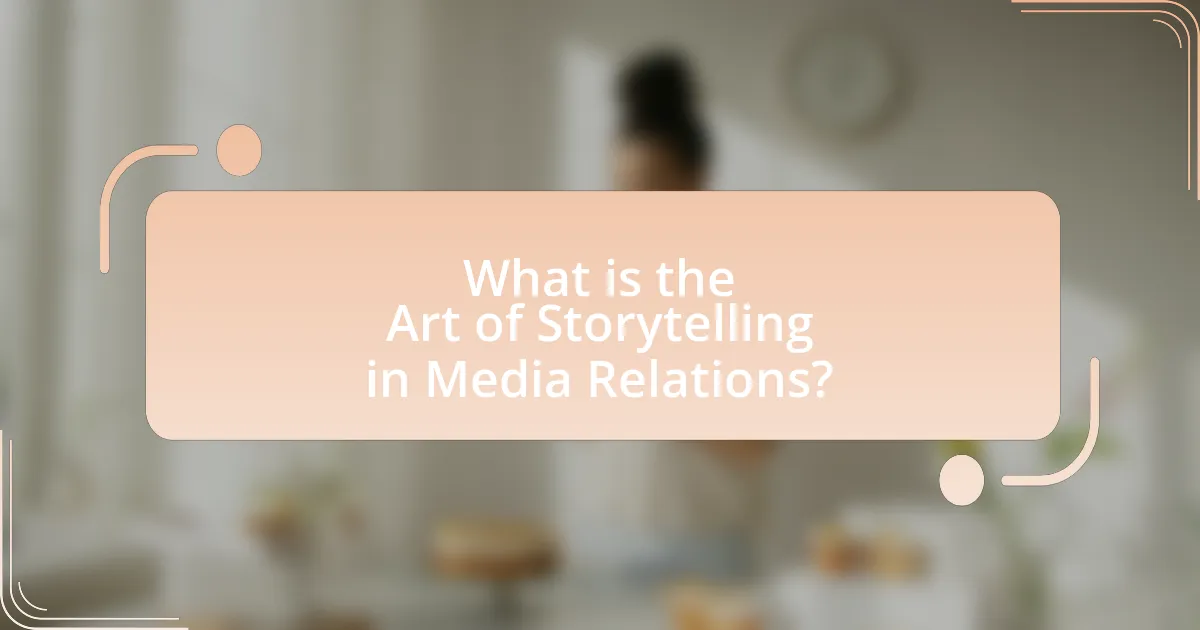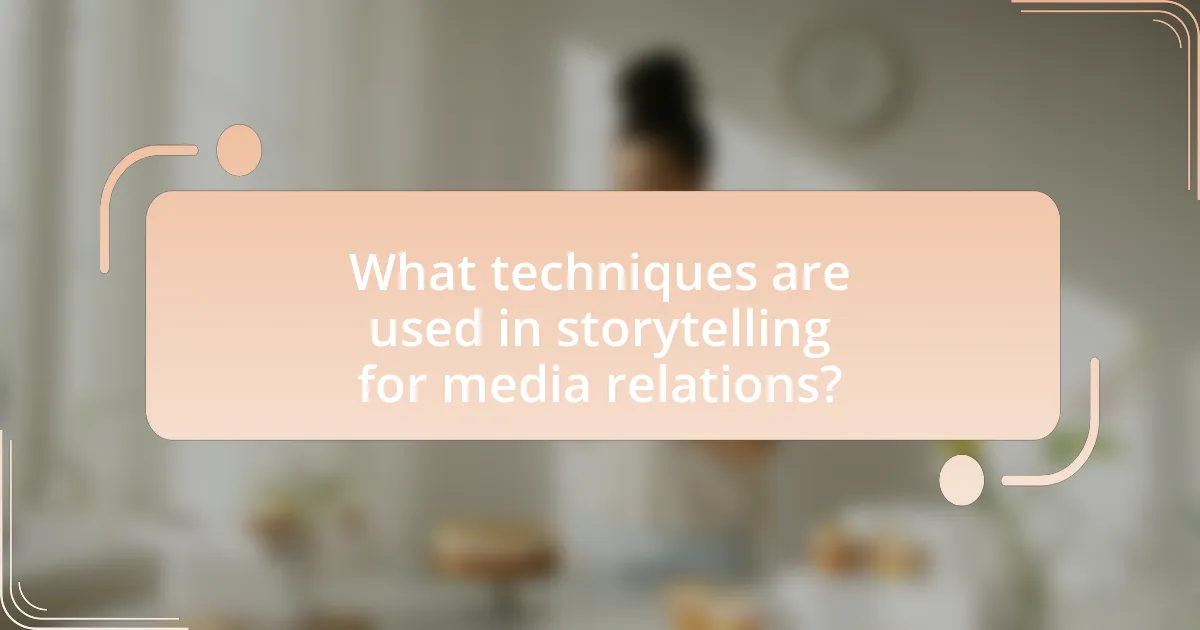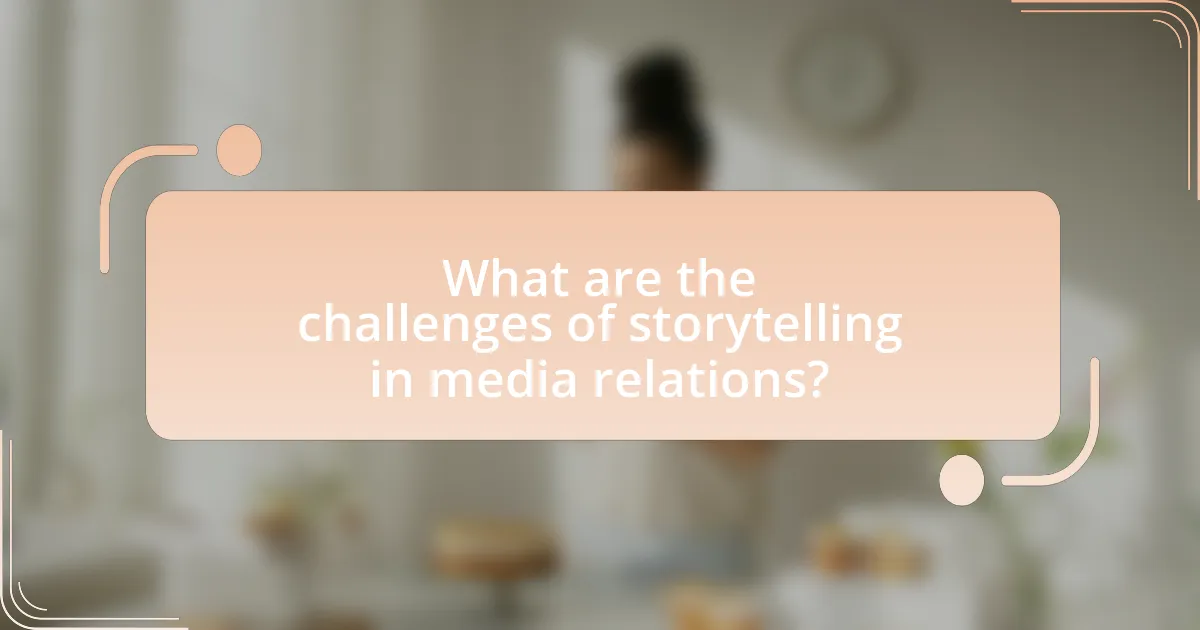The main entity of the article is the Art of Storytelling in Media Relations, which emphasizes the importance of crafting compelling narratives to engage audiences and communicate key messages effectively. The article outlines how storytelling enhances media relations by fostering emotional connections, building trust, and differentiating brands in a competitive market. Key elements of effective storytelling, such as clarity, emotional engagement, and relevance, are discussed, along with techniques and tools that support storytelling efforts. Additionally, the article addresses challenges in media storytelling, common pitfalls to avoid, and best practices for creating impactful narratives that resonate with target audiences.

What is the Art of Storytelling in Media Relations?
The Art of Storytelling in Media Relations involves crafting compelling narratives that engage audiences and effectively communicate key messages. This technique is essential for building relationships with journalists and media outlets, as stories that resonate emotionally are more likely to be shared and reported. Research indicates that stories can increase retention of information by up to 65%, making storytelling a powerful tool in media communications. By utilizing relatable characters, conflict, and resolution, media relations professionals can create narratives that not only inform but also inspire action and foster connections.
How does storytelling enhance media relations?
Storytelling enhances media relations by creating emotional connections that engage audiences and foster trust. When organizations share compelling narratives, they humanize their brand, making it relatable and memorable. Research indicates that stories are 22 times more memorable than facts alone, which underscores their effectiveness in capturing attention and facilitating communication. By utilizing storytelling, media relations professionals can convey complex information in an accessible manner, ultimately leading to stronger relationships with journalists and audiences alike.
What are the key elements of effective storytelling in media relations?
The key elements of effective storytelling in media relations include clarity, emotional engagement, relevance, and a strong narrative structure. Clarity ensures that the message is easily understood, while emotional engagement connects the audience to the story on a personal level, making it memorable. Relevance ensures that the story aligns with the interests of the target audience, increasing its impact. A strong narrative structure, which typically includes a beginning, middle, and end, helps to guide the audience through the story logically and compellingly. These elements are supported by research indicating that stories with emotional resonance and clear messaging are more likely to be shared and remembered, enhancing media relations efforts.
How does audience understanding influence storytelling techniques?
Audience understanding significantly influences storytelling techniques by shaping the narrative structure, tone, and content to resonate with the target demographic. When storytellers analyze their audience’s preferences, cultural background, and emotional triggers, they can tailor their messages to enhance engagement and relatability. For instance, research indicates that narratives incorporating familiar cultural references or addressing specific audience concerns lead to higher retention and impact, as seen in studies by the Pew Research Center, which highlight the importance of audience-centric communication in media. This alignment between audience understanding and storytelling techniques ultimately fosters a more effective and compelling narrative.
Why is storytelling important for media professionals?
Storytelling is crucial for media professionals because it enhances audience engagement and retention. By crafting compelling narratives, media professionals can convey complex information in a relatable manner, making it easier for audiences to connect with the content. Research indicates that stories are 22 times more memorable than facts alone, highlighting the effectiveness of storytelling in communication. This ability to create emotional connections through storytelling not only captivates audiences but also fosters trust and credibility, essential elements in media relations.
What role does storytelling play in building trust with the media?
Storytelling plays a crucial role in building trust with the media by creating relatable narratives that resonate with audiences. When media professionals receive well-crafted stories, they are more likely to perceive the information as credible and engaging, which fosters a sense of reliability. Research indicates that narratives can enhance memory retention and emotional connection, making the conveyed messages more impactful. For instance, a study published in the journal “Communication Research” found that stories significantly increase audience engagement and trust in the source, demonstrating that effective storytelling can bridge the gap between media outlets and their audiences.
How can storytelling differentiate a brand in a crowded market?
Storytelling can differentiate a brand in a crowded market by creating an emotional connection with consumers, which fosters loyalty and engagement. Brands that effectively use storytelling can convey their values, mission, and unique selling propositions in a relatable manner, making them more memorable. For instance, a study by the Harvard Business Review found that emotionally connected customers are more than twice as valuable as highly satisfied customers, indicating that storytelling can significantly enhance customer retention and brand preference. By weaving narratives that resonate with target audiences, brands can stand out amidst competition and cultivate a distinct identity.

What techniques are used in storytelling for media relations?
Techniques used in storytelling for media relations include the use of narrative structure, emotional appeal, and relatable characters. Narrative structure organizes information in a way that captures attention and maintains interest, often following a classic arc of beginning, middle, and end. Emotional appeal engages the audience’s feelings, making the story more memorable and impactful. Relatable characters help the audience connect personally with the story, enhancing engagement and fostering empathy. These techniques are supported by research indicating that stories with emotional resonance are more likely to be shared and remembered, as shown in studies by the Harvard Business Review, which highlight the effectiveness of storytelling in communication.
How can narrative structure improve media communication?
Narrative structure can improve media communication by providing a clear framework that enhances audience engagement and comprehension. When media content follows a structured narrative, it allows for a logical progression of ideas, making it easier for audiences to follow and retain information. Research indicates that stories are 22 times more memorable than facts alone, as demonstrated by a study published in the journal “Psychological Science,” which highlights the effectiveness of storytelling in conveying complex information. This structured approach not only captivates the audience but also fosters emotional connections, leading to a more impactful communication experience.
What are the different narrative structures that can be applied?
Different narrative structures that can be applied include linear, non-linear, circular, and fragmented structures. Linear narrative structures present events in chronological order, allowing for a straightforward progression of the story. Non-linear structures, on the other hand, may present events out of chronological order, often using flashbacks or flash-forwards to create suspense or depth. Circular narratives begin and end at the same point, emphasizing themes or character development through repetition. Fragmented structures consist of disjointed scenes or vignettes that may require the audience to piece together the story, often reflecting complex themes or emotions. These structures are widely recognized in literature and film, demonstrating their effectiveness in engaging audiences and conveying messages.
How does emotional appeal enhance storytelling effectiveness?
Emotional appeal enhances storytelling effectiveness by creating a deeper connection between the audience and the narrative. When stories evoke emotions such as joy, sadness, or empathy, they engage the audience on a personal level, making the content more memorable and impactful. Research indicates that emotionally charged stories are more likely to be shared and discussed, as they resonate with the audience’s experiences and feelings. For instance, a study published in the journal “Psychological Science” found that emotionally engaging narratives can significantly increase information retention and influence attitudes, demonstrating the power of emotional appeal in effective storytelling.
What tools and platforms support storytelling in media relations?
Tools and platforms that support storytelling in media relations include content management systems, social media platforms, and multimedia creation tools. Content management systems like WordPress enable organizations to publish and manage stories effectively, while social media platforms such as Twitter and Facebook facilitate the sharing and amplification of narratives. Multimedia creation tools like Canva and Adobe Spark allow for the development of visually engaging content that enhances storytelling. According to a 2021 report by the Content Marketing Institute, 70% of marketers believe that storytelling is essential for effective communication in media relations, highlighting the importance of these tools in crafting compelling narratives.
Which digital tools can enhance storytelling efforts?
Digital tools that can enhance storytelling efforts include content management systems, social media platforms, video editing software, and graphic design applications. Content management systems like WordPress enable easy organization and publication of stories, while social media platforms such as Instagram and Twitter facilitate real-time audience engagement and sharing. Video editing software like Adobe Premiere Pro allows for the creation of compelling visual narratives, and graphic design applications such as Canva help in producing eye-catching visuals that complement the storytelling process. These tools collectively improve the effectiveness and reach of storytelling in media relations by providing diverse formats and channels for audience interaction.
How can social media be leveraged for storytelling in media relations?
Social media can be leveraged for storytelling in media relations by creating engaging narratives that resonate with target audiences. Platforms like Twitter, Instagram, and Facebook allow organizations to share real-time updates, behind-the-scenes content, and user-generated stories, enhancing the emotional connection with the audience. For instance, a study by the Pew Research Center found that 69% of adults in the U.S. use social media, indicating a vast potential reach for storytelling efforts. Additionally, using multimedia elements such as videos and infographics can increase engagement rates, as posts with visuals are known to receive 94% more views than text-only posts. This strategic use of social media not only amplifies the reach of stories but also fosters community interaction and feedback, making storytelling more dynamic and impactful in media relations.

What are the challenges of storytelling in media relations?
The challenges of storytelling in media relations include maintaining audience engagement, ensuring message clarity, and navigating diverse media platforms. Audience engagement is critical, as stories must resonate with various demographics to be effective; for instance, a study by the Pew Research Center found that 62% of Americans prefer visual storytelling, indicating the need for compelling visuals alongside narratives. Message clarity is essential to avoid misinterpretation; research shows that 70% of communication failures stem from unclear messaging. Additionally, the proliferation of media platforms complicates storytelling, as each platform has unique formats and audience expectations, requiring tailored approaches to effectively convey the story.
What common pitfalls should be avoided in media storytelling?
Common pitfalls to avoid in media storytelling include lack of clarity, failure to engage the audience, and neglecting the importance of fact-checking. Clarity is essential; if the message is convoluted, the audience may misunderstand or lose interest. Engaging the audience is crucial; stories that do not resonate or connect emotionally are less likely to be impactful. Additionally, neglecting fact-checking can lead to misinformation, damaging credibility and trust. For instance, a study by the Pew Research Center found that 62% of Americans believe fabricated news stories cause confusion about basic facts, highlighting the importance of accuracy in storytelling.
How can miscommunication affect storytelling outcomes?
Miscommunication can significantly alter storytelling outcomes by distorting the intended message and leading to misunderstandings among the audience. When storytellers fail to convey their ideas clearly, the audience may interpret the narrative differently than intended, resulting in confusion or disengagement. For instance, a study published in the Journal of Communication found that 70% of communication failures in organizations stem from misunderstandings, which can similarly apply to storytelling in media relations. This misalignment can diminish the impact of the story, reduce audience trust, and ultimately hinder the effectiveness of the communication strategy.
What strategies can mitigate the risks of storytelling failures?
To mitigate the risks of storytelling failures, organizations should implement thorough audience analysis, clear messaging, and iterative feedback loops. Audience analysis ensures that the story resonates with the target demographic, as evidenced by studies showing that tailored content increases engagement by up to 60%. Clear messaging reduces ambiguity, which is crucial since 70% of communication failures stem from unclear messages. Iterative feedback loops allow for real-time adjustments based on audience reactions, enhancing the story’s effectiveness. By employing these strategies, organizations can significantly reduce the likelihood of storytelling failures in media relations.
How can storytelling be measured for effectiveness?
Storytelling can be measured for effectiveness through various metrics such as audience engagement, retention rates, emotional response, and conversion rates. Audience engagement can be quantified by analyzing social media interactions, comments, and shares, which indicate how well the story resonates with the audience. Retention rates can be assessed by tracking how many viewers or readers continue to engage with the content over time, reflecting the story’s ability to hold attention. Emotional response can be gauged through surveys or feedback mechanisms that capture audience feelings and reactions, providing insight into the story’s impact. Conversion rates, particularly in marketing contexts, measure how effectively a story drives desired actions, such as purchases or sign-ups, demonstrating its persuasive power. These metrics collectively provide a comprehensive view of storytelling effectiveness in media relations.
What metrics are useful for evaluating storytelling success?
Metrics useful for evaluating storytelling success include audience engagement, reach, and conversion rates. Audience engagement can be measured through likes, shares, comments, and time spent on content, indicating how well the story resonates with the audience. Reach is quantified by the number of unique viewers or readers, reflecting the story’s visibility. Conversion rates assess the effectiveness of the storytelling in prompting desired actions, such as signing up for a newsletter or making a purchase. These metrics provide concrete evidence of a story’s impact and effectiveness in media relations.
How can feedback be incorporated to improve storytelling techniques?
Feedback can be incorporated to improve storytelling techniques by systematically gathering and analyzing audience responses to narratives. This process allows storytellers to identify strengths and weaknesses in their techniques, enabling targeted enhancements. For instance, surveys and focus groups can reveal which elements resonate with audiences, such as character development or plot pacing. Research indicates that stories that align with audience expectations and preferences lead to higher engagement rates, as demonstrated in studies by the Nielsen Norman Group, which found that user feedback significantly improves content effectiveness. By integrating this feedback loop, storytellers can refine their narratives to better connect with their audience, ultimately enhancing the overall impact of their storytelling.
What are best practices for effective storytelling in media relations?
Effective storytelling in media relations involves crafting a compelling narrative that resonates with the target audience. To achieve this, communicators should focus on clarity, emotional engagement, and relevance. Clarity ensures that the message is easily understood, while emotional engagement captures the audience’s attention and fosters a connection. Relevance aligns the story with the audience’s interests and current events, enhancing its impact.
Additionally, using real-life examples and data can strengthen the narrative. For instance, a study by the Content Marketing Institute found that stories that include statistics are 22 times more memorable than those that do not. This demonstrates that integrating factual evidence into storytelling not only enhances credibility but also aids retention.
How can media professionals craft compelling narratives?
Media professionals can craft compelling narratives by focusing on clear structure, emotional engagement, and authenticity. A well-defined narrative structure typically includes a strong opening, a conflict or challenge, and a resolution, which helps to maintain audience interest. Emotional engagement is achieved through relatable characters and situations, allowing the audience to connect personally with the story. Authenticity is crucial; narratives that reflect genuine experiences or truths resonate more deeply with audiences. Research indicates that stories with emotional appeal are 22 times more memorable than facts alone, highlighting the importance of emotional connection in storytelling.
What tips can enhance the impact of storytelling in media relations?
To enhance the impact of storytelling in media relations, focus on crafting a compelling narrative that resonates with the target audience. Engaging stories should include relatable characters, a clear conflict, and a resolution that aligns with the audience’s values or interests. Research indicates that narratives can increase information retention by up to 65%, making them more effective than traditional communication methods. Additionally, incorporating data and real-life examples can lend credibility to the story, further engaging journalists and their audiences.